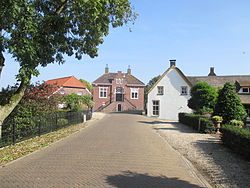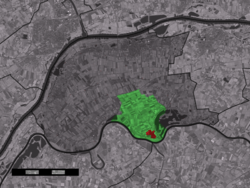Maasbommel
Maasbommel | |
|---|---|
Town | |
 | |
 | |
 The town centre (red) and the statistical district (light green) of Maasbommel in the municipality of West Maas en Waal. | |
| Coordinates: 51°49′15″N 5°32′11″E / 51.82083°N 5.53639°E | |
| Country | Netherlands |
| Province | Gelderland |
| Municipality | West Maas en Waal |
| Area | |
| • Total | 10.68 km2 (4.12 sq mi) |
| Population (31 December 2008) | |
| • Total | 1,343 |
| • Density | 130/km2 (330/sq mi) |
| Time zone | UTC+1 (CET) |
| • Summer (DST) | UTC+2 (CEST) |
| Postal code | 6627 |

Maasbommel is a town in the Dutch province of Gelderland. It is a part of the municipality of West Maas en Waal, and lies about 7 km north of Oss. It received city rights in 1328.
Maasbommel was a separate municipality until 1818, when it was merged with Appeltern.[1]
In 2001, the town of Maasbommel had 615 inhabitants. The built-up area of the town was 0.28 km², and contained 255 residences.[2] The statistical area "Maasbommel", which also can include the peripheral parts of the village, as well as the surrounding countryside, has a population of around 1320.[3]
Maasbommel is known as the place where pioneering floating amphibious houses have been built.[4][5][6][7]
References
- ^ Ad van der Meer and Onno Boonstra, Repertorium van Nederlandse gemeenten, KNAW, 2011.
- ^ Statistics Netherlands (CBS), Bevolkingskernen in Nederland 2001 Archived 2006-03-19 at the Wayback Machine. (Statistics are for the continuous built-up area).
- ^ Statistics Netherlands (CBS), Statline: Kerncijfers wijken en buurten 2003-2005. As of 1 January 2005.
- ^ Kroeger, Alix (2007-03-01). "Dutch pioneer floating eco-homes". BBC News. Retrieved 2010-07-21.
- ^ "Amphibious Houses: Dutch Answer to Flooding: Build Houses that Swim - SPIEGEL ONLINE - News - International". Spiegel.de. Retrieved 2010-07-21.
- ^ "From floating houses to rafts of hyacinths". Post Carbon Cities. 2007-11-26. Archived from the original on 2011-07-17. Retrieved 2010-07-21.
- ^ "Dutch Architects Plan for a Floating Future". NPR. Retrieved 2010-07-21.

